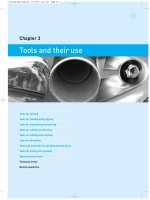Automotive mechanics (volume i)(part 1, chapter7) workshop safety
Bạn đang xem bản rút gọn của tài liệu. Xem và tải ngay bản đầy đủ của tài liệu tại đây (1.3 MB, 10 trang )
097-106_May_chap 07
12/9/06
9:48 AM
Page 97
97
Chapter 7
Workshop safety
Personal safety
Safety with machines and equipment
Safety with motor vehicles
Safety with vehicle components
Safety with engines
Safety with batteries
Fire safety
Fires
Fire extinguishers
First aid
Technical terms
Review questions
097-106_May_chap 07
98
12/9/06
9:49 AM
Page 98
part one introduction to motor vehicles
Safety in the workshop is mainly a matter of common
sense. Good habits can be developed so that things are
always done in a safe way. However, unsafe practices
can also become a bad habit that will be difficult to
break. Start correctly and then safe working practices
will become automatic.
In a workshop, people have to consider the safety
of others as well their own. They must understand
general workshop safety requirements and, in particular, the need for safety when operating machines and
when working on or around motor vehicles. If this is
done, then a workshop becomes a safe place in which
to work.
Personal safety
Some of the items that are a personal responsibility are
noted below. Attention to things such as these will
help to prevent personal injury.
Clothing
Suitable clothing should always be worn in the
workshop. Loose sleeves and other loose clothing can
easily catch on parts of a vehicle or tangle in workshop
equipment. Rotating parts, such as fans, belts and
drills, are particularly dangerous as these could catch a
loose sleeve and quickly pull a hand into a moving
part.
The same problems exist with long hair, which can
become tangled in rotating parts. An accident of this
type can cause severe personal injury. Always tie back
long hair or wear a cap or other headgear.
Footwear
Boots and shoes should be of stout design. Good
footwear will protect feet against hazards at floor level
as well as objects that might fall or be dropped. Safety
footwear is designed with reinforced toecaps to
provide protection against these types of accidents.
■ Open or soft footwear should not be worn in the
workshop.
Safety glasses and shields
Eyes need special protection. Clear safety glasses
should be worn when using a grinding wheel, or for
any workshop job where dust or metal particles are
prevalent (Figure 7.1).
Dark glasses are used during gas (oxy-acetylene)
welding. These enable the weld to be seen and also
figure 7.1
Safety goggles should be worn for eye
protection
protect the eyes against the intense light, heat and
sparks.
For arc welding, a special face shield with a dark
glass window is used. Arc welding produces rays
which can permanently damage the eyes and burn the
skin unless a protective face shield is used and
adequate clothing worn. During arc welding, the body
must be completely covered and the hands and arms
protected by leather gloves. It is dangerous to watch or
operate an arc welder without such equipment.
■ All welding produces heat, so welded parts must be
handled carefully to prevent burns. Hot articles
must not be left where they can be accidentally
touched.
Safety and tools
Small hand tools should be kept clean and tidy. They
should be used correctly and maintained in good
condition. Hammer heads should be secure,
screwdrivers and chisels should be ground to the right
shape, and drills and punches should be sharpened
correctly.
Larger tools should be kept under control and not
scattered about. Keep equipment out of aisles and
working spaces where they would become a hazard.
Take special care with jack handles and creepers.
Using compressed air
Use air pressure carefully. Never point an air gun or
hose at yourself or towards another person. Particles of
097-106_May_chap 07
12/9/06
9:49 AM
Page 99
chapter seven workshop safety
99
dirt can be blown at sufficient speed to enter the eyes or
penetrate the skin. High-pressure air forced against the
skin is very dangerous, for it can enter the bloodstream.
Safety with machines
and equipment
Workshop equipment is expensive and must be treated
with care – the operator is responsible for using it
safely. Safety with machines and equipment implies
that they will be used correctly and so prevent damage
or undue wear, as well as avoiding injury to the
operator or other persons.
Use of machines
Before using a machine, know how it works – check
the instructions before using any unfamiliar machine.
It is good practice to carry out checks and minor
maintenance before a machine is used so that it always
remains in a serviceable condition.
Keep hands away from moving parts. When using
machine tools, do not attempt to ‘feel’ the finished
surface with the machine in operation. Machines
should be stopped before any checks or measurements
are made.
Machine guards
Guards should be fitted to machines that have external
moving parts. The guards are there to protect the
operator, who should make sure that the guards are
correctly in place.
Grinders should have covers over the grinding
wheels to prevent grindings from being thrown
towards the operator. The tool rests should always be
adjusted close to the edges of the wheels. This will
prevent an article that is being ground from jamming
between the tool rest and the grinding wheel. This
could injure the operator, damage the wheel, or ruin
the article being ground.
Wheel balancers are another example where safety
guards are used. A guard over the tyre will protect the
operator from dust or from small stones that might be
dislodged from the tread.
Electrical tools
Portable electrical tools should be maintained in good
condition and used correctly. Check the condition of
cables and plugs before use (Figure 7.2). Any
maintenance that is necessary should be carried out by
a qualified electrician.
figure 7.2
Look after portable electric tools – for
example
1 treat drill carefully, 2 cable in good condition, 3 plug fitted
correctly, 4 ventilation slots clear, 5 key kept with the drill
Workshops should have an earth-leakage device
connected into their electrical power supply. This
provides protection from faulty electrical appliances
that are used from three-pin power outlets. The earthleakage device will trip to prevent a fatal electrical
shock if an appliance is faulty.
Larger electrical tools are earthed by having the
third (earth) wire in their cable connected to the metal
body of the tool. Many smaller electrical tools are not
earthed, but are double-insulated for operator
protection. These have only two wires in their cable
and should not be earthed.
■ Electricity is a potential killer that can strike
without warning – it can be neither seen nor heard.
Properly used, it is harmless, but carelessly used, it
is extremely dangerous.
Safety with motor vehicles
Mechanics should appreciate the value of the motor
vehicles that are in their care for service or repair.
A motor vehicle is a complex piece of machinery and
should be treated as such, whether being worked on or
driven.
Responsible driving protects the mechanical parts,
prolongs vehicle life and prevents accidents. When
parking, make sure that the vehicle is safe: that is,
apply the parking brake and place a manual transmission in reverse, or an automatic transmission in
park.
097-106_May_chap 07
12/9/06
9:49 AM
Page 100
100 part one introduction to motor vehicles
Protecting the vehicle
When working on a vehicle, the paintwork and
upholstery must be protected from being marked or
damaged. Covers should be used on mudguards and
upholstery to keep them clean (Figure 7.3).
Hydraulic brake fluid will remove paint and so any
fluid that spills must be cleaned up immediately. Use a
cleaning rag and wash the area with plenty of water.
Hydraulic brake fluid can cause skin irritation if it
comes into contact with hands or other parts of the
body. The fluid should be washed off with soap and
water.
Engine coolant will also remove paint – spills
should be removed by flushing with water.
Fuel leaks are a fire hazard and should be corrected
as soon as they are discovered.
Oil leaks make a mess and a severe oil leak from
the engine could cause engine failure, with permanent
damage to engine parts.
Jacking and raising vehicles
figure 7.3
Use covers to protect the paintwork and
upholstery of the vehicle HYUNDAI
The final operation of any workshop job should be
to ensure that the vehicle is clean and ready for use.
The tyres, engine oil, coolant, brake fluid and fuel
should be checked, whether they were part of the
repair or not, before the vehicle can be considered
ready for delivery (Figure 7.4).
■ Figure 7.4 illustrates one way of remembering that
there are five essential items to be checked.
engine oil
coolant
Jacks must be placed securely under vehicles and used
only at the correct jacking points (Figure 7.5). An
incorrectly placed jack will not only damage the
vehicle, but it could slip, allowing the vehicle to fall
and cause personal injury.
Stands should be used to support a vehicle after it
has been raised by a jack. These must also be placed
under jacking points to prevent damage. Stands must
be used if work is to be done under a vehicle – never
work under a vehicle that is supported only by a
jack.
Vehicles being raised on a hoist should be suitably
positioned, with the lifting arms or pads correctly
placed. Failure to do this will create an unsafe
situation and could also cause structural damage to the
vehicle.
brake fluid
tyres
fuel
figure 7.4
■ Refer to Chapter 33: Service and maintenance,
where jacking and lifting are treated in more
detail.
Five checks for the safe operation of a motor
vehicle
Spills, leaks and splashes
Clean up spills and splashes when they happen. This
includes brake fluid, oils, fuel and coolant.
figure 7.5
Jack a vehicle safely and place lifting stands
in the right places HYUNDAI
097-106_May_chap 07
12/9/06
9:49 AM
Page 101
chapter seven workshop safety
Safety with vehicle components
101
airbag
Some components that are being dismantled are under
load and require special precautions to prevent injury.
For example, care is needed with compressed springs,
particularly suspensions, where correct jacking is
needed to relieve the load before the spring
is removed. Special tools are sometimes used to hold
the spring during and after removal (Figure 7.6).
dash
figure 7.7
A passenger’s air bag that has been deployed
Safety with engines
Care should be taken with running engines. Engines
produce a number of different emissions which come
from the exhaust to pollute the atmosphere
(Figure 7.8). One of these is carbon monoxide, which
is a deadly gas and so a vehicle must be in a wellventilated area whenever the engine is running.
figure 7.6
Tool being used to safely hold a suspension
spring – if mishandled, a compressed spring
is dangerous
■ If an engine is run in a closed garage, carbon
monoxide will quickly fill the space. It is invisible
and has no odour to provide a warning that a
deadly gas is present.
Brake and clutch dust
Dust should not be blown from brake or clutch parts.
Airborne dust can be inhaled and this presents health
problems. Asbestos fibres were used for brake linings
and clutch facings, but the use of asbestos has been
phased out because of health issues.
Air bag precautions
There are certain precautions that must be observed
when working on vehicles which have air bags. Air
bags are deployed by crash sensors which electrically
start the igniter of the air bag.
When an air bag is deployed, it suddenly inflates
(Figure 7.7). There will be a loud noise, some smoke
and white powder. As the air bag deflates it will
release nitrogen gas, which is harmless. The metal
parts will be hot.
■ Air bags will accidentally deploy if the crash
sensors are disturbed or voltage wrongly applied to
the air bag wiring.
HC
CO
NOx
figure 7.8
Emissions from the exhaust pipe include
hydrocarbon (HC), carbon monoxide (CO) and
nitrous oxides (NOx)
Engine moving parts
Unless it is necessary to have an engine running, work
should be done with the engine stopped. If an engine is
running, make sure that hands or clothing do not foul
any moving parts. Pay particular attention to drive
belts, pulleys and fans. Many engines have a long belt
driving a number of pulleys, others have two or more
belts which must be avoided.
Care is needed with electric fans. They are
temperature-controlled and do not run continuously.
With the ignition switch on and the engine running, a
stationary fan could start when least expected.
097-106_May_chap 07
12/9/06
9:49 AM
Page 102
102 part one introduction to motor vehicles
Cooling system
The coolant in the engine and radiator reaches
temperatures above the boiling point of water. The
coolant is also under pressure and scalding coolant will
be forced from the radiator if the radiator cap is
removed when the engine is hot.
To avoid scalding of hands, face or arms, the
radiator cap should be removed only when the engine
is cold. However, if the cap has to be removed before
an engine has cooled down, then it should be covered
with a heavy pad of rag. The cap should be turned only
as far as its first stop until the pressure has been
relieved. Then, the cap can be completely removed.
■ All parts of the cooling system operate at high
temperatures and care is needed to avoid burns.
low level, so adequate workshop ventilation is
necessary.
There are also other restrictions, such as not
welding close to LPG. (Refer to Chapter 14: Gas fuel
systems, for more information.)
■ LPG acts as a refrigerant when it is released. Do
not touch any metal gas fittings or allow gas to
come into contact with any part of the body.
Safety with batteries
Care is needed when working with or near batteries.
They should be handled and maintained correctly,
because they can cause corrosion, produce gas,
produce sparks and cause burns (Figure 7.9). Following are points about batteries.
Exhaust system
The exhaust manifolds and the other parts of the
exhaust system reach high temperatures. To prevent
burns, the engine and associated parts should be
allowed to cool before working on these components.
Ignition system
Make sure that the ignition switch is turned off and the
engine stopped before working on or near the ignition
system.
The ignition system produces exceedingly high
voltages and these can be dangerous. Contact with any
part of the ignition system while the engine is running
should be avoided. People with heart pacemakers should
be particularly careful of the high voltages which could
affect the pacemaker’s operation.
Fuel and fuel system
Possible petrol leaks in a vehicle’s fuel system,
particularly around the engine compartment, should
be attended to immediately. Leaks are extremely
dangerous because they can be close to hot exhaust
manifolds or parts of the ignition or electrical systems.
A spark would be sufficient to cause a fire if vapours
from a petrol leak were present.
LPG fuel system
There are particular safety requirements for vehicles
that have a liquid petroleum gas (LPG) fuel system.
The fuel must be turned off at the fuel tank and gas
cleared from the lines before repairs are carried out.
LPG is heavier than air and so can become trapped at a
figure 7.9
Possible hazards when working with batteries
1. Batteries contain sulphuric acid which can irritate
the skin, damage clothing and corrode metal parts.
2. Burns can result if electrical contact is made with
the battery terminals, or between the ‘live’ terminal
and the engine or body. Take care when using tools
on or near battery terminals.
3. The battery can be isolated by disconnecting the
cable from the ground terminal of the battery
(Figure 7.10).
4. Disconnect the battery if work is to be done on any
electrical component or circuit. Failure to do this
could damage the electrical system. Most modern
vehicles will require an alternate electrical source
when the main battery is disconnected. This is easily
done by plugging a 9V ‘battery saver’ into the
097-106_May_chap 07
12/9/06
9:49 AM
Page 103
chapter seven workshop safety
cigarette lighter outlet before disconnecting the main
battery – 9V is sufficient for electronic systems to
maintain their memory for such accessories as audio
components and climate control systems.
negative
battery cable
figure 7.10
Remove the negative battery terminal to
isolate the battery HYUNDAI
5. Disconnect the battery if it is to be recharged in the
vehicle. This will prevent possible damage to
electrical components.
6. During charging, a battery produces an explosive
gas which will damage the battery if accidentally
ignited. Sparks and flame should be kept away from
batteries that are being recharged.
■ Wash off any battery acid that comes into contact
with the skin. For eyes, flush with plenty of clean
water and seek medical advice.
103
Petrol is a highly flammable liquid that must be
handled and stored carefully. Petrol gives off vapours
at room temperature. These are easily ignited by a
spark or flame, and so safety precautions must be
observed wherever petrol is used. For this reason,
‘No smoking’ signs are displayed in many
workshops.
Distillate is not as volatile as petrol. It requires
higher temperatures to produce vapour and so is less of
a hazard.
Oily rags and waste are a potential source of fire.
These can be ignited by spontaneous combustion. That
is, the oil on the rags causes so much heat to develop
(by chemical action) that the rags catch on fire. Oily
rags and waste should be placed in covered metal
containers provided for this purpose.
Welding creates heat and sparks that could start a
fire if used carelessly. A spark could ignite liquids
such as petrol, cleaning fluids and solvents. Welding
should be confined to a welding bay, as far as possible.
When welding on a vehicle, precautions should be
taken in relation to the closeness of fuel, whether it
is in the fuel tank, fuel lines, or in the engine
compartment.
Gas fuels (LPG and NGV) have special safety
precautions and there are special regulations that apply
to vehicles with gas fuel systems. (Gas fuel systems
are covered in Chapter 14.)
High voltage systems
Vehicles are now being produced that operate on higher
voltage than 12V DC. Some components also operate
on alternating current (AC) internally at high enough
voltages to cause injury or even kill. Some examples
are diesel injection, traction control, anti-lock brakes
(ABS) and hybrid vehicles. The manufacturer’s
instructions should always be consulted and followed.
Fires
Fire safety
3. Heat. This is needed to bring the fuel to a
temperature at which it will start to burn.
Fire safety is about being aware of the potential fire
hazards in a workshop and minimising them. It is
about having appropriate firefighting equipment
available and knowing how to use it quickly if a fire
starts. It is also about knowing how to contact
emergency services for help.
For a fire to occur (combustion), three things must be
present:
1. Fuel. This can be any combustible material – a
liquid, a solid or a gas.
2. Air. This provides oxygen, which is required to
sustain combustion.
All combustible materials must be converted into a
vapour before they will burn, and it is the vapour that
actually burns. Different fuels, or combustibles, will
vaporise at different temperatures. Those that vaporise
at low temperatures, such as petrol, are classed as
flammable materials.
Fire hazards
Some of the fire hazards in an automotive workshop
are related to petrol, distillate, cleaning solvents, oily
rags, welding and smoking.
Extinguishing fires
Figure 7.11 shows a triangle of combustion. Each
side of the triangle represents one of the three
097-106_May_chap 07
12/9/06
9:49 AM
Page 104
104 part one introduction to motor vehicles
Fire extinguishers
figure 7.11
The triangle represents the three elements
of a fire – air, fuel and heat – remove one side
of the triangle and it will collapse, just as removing one
element of the fire will extinguish it
There is no single type of extinguisher that would suit
all classes of fires, so fire extinguishers are designed
for use on particular classes of fires. This is necessary
because burning liquids require different treatment to
burning solids, and conducting materials cannot be
used on electrical equipment.
When a solid material is on fire, it can usually be
cooled down with water to a temperature where it will
no longer burn.
A liquid fire has to have the air supply blocked off
in some way. Air contains oxygen which is necessary
to sustain all forms of combustion. When the air is
blocked off, burning can no longer take place.
An electrical fire should have the power supply
isolated and then the fire smothered.
Extinguisher identification
elements needed for combustion – fuel, air and heat.
The principle of extinguishing a fire is based on
removing one of these:
1. Removing fuel. If the fuel is removed, the fire will
starve and will go out.
2. Excluding air. If air is excluded by smothering the
fire, there will be no oxygen and combustion can no
longer take place.
The different types of fire extinguishers are identified by
their colour. They can also be identified by the class of
fire (A to E) for which they are suitable for use. The
extinguishers commonly found in automotive workshops
are foam, carbon dioxide, and powder (Figure 7.12).
Types of extinguishers are noted below, but the best
way of becoming familiar with them is to check the
extinguishers in your workshop and read the instructions on the labels.
3. Reducing the heat. If heat is reduced, the
temperature will drop and combustion will cease.
Classes of fires
The various types of fires are separated into classes as
follows:
1. Class A fires: Fires with solid materials, such as
paper, wood, cloth etc.
2. Class B fires: Fires with flammable liquids, such as
petrol, kerosene, methylated spirits and paints.
3. Class C fires: Fires with flammable gases, such as
LPG and NGV.
4. Class D fires: Burning metals, such as magnesium,
sodium and lithium.
5. Class E fires: Live electrical equipment fires, such
as in switchboards, electric equipment, motors,
switches or appliances.
■ Electricity is not a fuel, but it can generate heat and
high temperatures which can cause a fire and it can
still be present during a fire.
blue
A + B foam
figure 7.12
red/black
B + E carbon dioxide
red/white
B + E powder
Fire extinguishers for automotive workshops
Foam extinguishers
These are used for class A and B fires. They must not
be used on electrical fires. They are blue in colour and
eject foam, which can be used on petrol and similar
liquid fires. The foam blankets the liquid to cut off the
air supply.
097-106_May_chap 07
12/9/06
9:49 AM
Page 105
chapter seven workshop safety
If the fire is in a container of liquid, the foam
should be directed to the side of the container so that it
spreads across the surface of the liquid.
Carbon dioxide extinguishers
These are suitable for class B and E fires, but they are
safe for all classes of fires. They are red/black in
colour and consist of a pressure cylinder which
contains carbon dioxide. When directed at a fire, the
gas removes the oxygen and cools the burning material
to below combustion temperature.
■ Caution – do not allow the discharging gas to come
into contact with the fingers as it can cause frostbite.
Hold the discharge nozzle by the plastic horn.
Powder extinguishers
These are suitable for class B, C and E fires. These are
red extinguishers with a white band. They expel a fine
powder which smothers the fire and also absorbs some
of the heat.
Using a fire extinguisher
P-A-S-S is the ‘password’ for using fire extinguishers.
This stands for pull, aim, squeeze and sweep:
1. Pull the pin at the top of the extinguisher to release
the handle.
2. Aim the nozzle towards the base of the fire.
3. Squeeze the handle to discharge the extinguishing
material. (Release the handle to stop.)
4. Sweep the nozzle back and forth at the base of the
fire.
When the fire has been extinguished, keep a check to
make sure that it does not reignite.
First aid
The objective in all workshops should be to remove
hazards and so prevent workshop accidents. However,
if an accident does occur, then correct first aid
treatment is needed.
First aid means rendering immediate assistance in
the event of an accident or sudden sickness. The most
important actions are those which save life, for
example, resuscitation, stoppage of severe bleeding
and treatment of poisoning.
All workshops should have at least one person who
is fully trained in first aid and who knows what to do
in an emergency. If an accident occurs in a workshop,
or there is a case of sudden illness, a person with firstaid training will know how to handle the situation.
In an emergency, a person in a position to render
first aid must know how to act quickly. In all cases of
serious accident, professional medical aid should be
sought immediately.
Technical terms
Earth leakage, earth, earthed, hazard, jacking points,
sulphuric acid, battery charging, negative terminal,
air bag, deploy, nitrogen gas, crash sensor,
emissions, carbon monoxide, LPG, NGV, refrigerant, magnesium, sodium, lithium, flammable,
combustion, spontaneous combustion, combustible
material, combustibles, extinguisher, carbon
dioxide, first aid, resuscitation.
Review questions
1.
Identify some important items of personal
safety.
2.
How can you help to ensure the safety of other
people?
3.
What precautions should be taken when using
compressed air?
4.
List some precautions that are needed in relation
to workshop machines.
5.
Before using a machine, what general check
should be carried out?
6.
What safety precautions relate to portable tools?
7.
What precautions should be taken when parking
a vehicle?
Water and other methods
For other than electrical or liquid fire, water from a
hose is most commonly used. It can be used as a jet to
reduce the temperature, or as a spray to restrict the air.
Sand thrown over most small fires will extinguish
them. A sack or similar cover can be used to blanket
the flames in small fires.
Clothing on fire can be extinguished by wrapping
the wearer in a special fire blanket. This again cuts
off the air supply and extinguishes the flames.
■ Prompt action at the start of a fire, using any
suitable material available, could stop the fire and
prevent it spreading.
105
097-106_May_chap 07
12/9/06
9:49 AM
Page 106
106 part one introduction to motor vehicles
8.
When working on an engine, how could the
bodywork be protected?
9.
Why are the jacking points of a vehicle
important?
10.
Why should special care be taken when working
with batteries?
11.
Why is it necessary to take care with air bags?
12.
Name some of the hazards associated with a
running engine.
13.
What is a flammable liquid?
14.
What is spontaneous combustion?
15.
What are combustible materials?
16.
How does air affect a fire?
17.
What are the classes of fires?
18.
What type of extinguisher should be used on an
electrical fire?
19.
When would a foam-type extinguisher be
used?
20.
What is meant by first aid?









